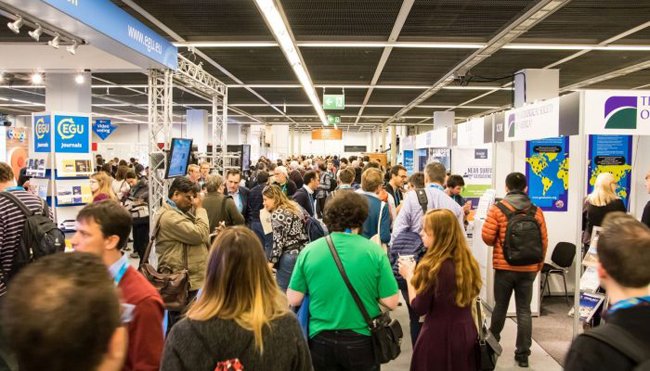
TODAY'S SCIENCE FOR OCEANS OF TOMORROW: MEDCLIC IN THE EGU GENERAL ASSEMBLY 2018
10/04/2018
During this week, Viena is celebrating the research in Ocean Sciences in the European Geosciences Union General Assembly (EGU) 2018.
In this frame, a talk about the SOCIB Western Mediterranean circulation model will explain the impacts of downscaling the CMEMS (the Copernicus Marine Environment Monitoring Service) Mediterranean model to represent the fine scales associated with the mesoscale variability and coastal processes. This talk will be given by Eva Aguiar, of the MEDCLIC program, next Friday the 13th of April.
The research focuses on the impact of downscaling the CMEMS Mediterranean model over the Western basin. This is evaluated using the high resolution Western Mediterranean Operational model (WMOP, ∼2km spatial resolution) developed at SOCIB, the Balearic Islands Coastal Observing and Forecasting System. WMOP uses the larger scale CMEMS Med model (v02, ∼6km resolution) as initial and boundary conditions. Downscaling effects are assessed considering in particular 1) the mean surface spatial flows over three strategic areas monitored with High Frequency Radars (HFR), and 2) the spatial distribution, number, size and lifetime of mesoscale eddies. The model evaluations as well as the quantification of the impacts of downscaling are achieved through a multi-platform perspective which includes high-resolution surface currents observations from HFR, glider transports across a key-section, and satellite altimetry data.

The Mediterranean Sea is often considered as a small scale ocean laboratory where energetic eddies, fronts and circulation features have important ecological consequences. Downscaling the CMEMS Mediterranean model over a reduced area allows to reproduce the fine scale variability and coastal processes with a higher resolution, and the interactions between mean flows and mesoscale eddies in particular.

WMOP: a high-resolution numerical model nested in the CMEMS Mediterranean model (CMEMS Med Rea)
A better understanding of ocean variability and ecosystems’ response requires the coordination of a continuous and long-term system of ocean observation at different scales and covering from the nearshore to the open ocean. In particular, it is necessary to anticipate the adaptation to the evolution of the climate of our planet and to preserve healthy and sustainable oceans for future generations.
The research has been carried out by SOCIB (1) and IMEDEA (2) members (Eva Aguiar (1), Baptiste Mourre (1), Emma Reyes (1), Jaime Hernandez-Lasheras (1), Emma Heslop (1), Melanie Juza (1), Evan Mason (2), Joaquin Tintore (1, 2) as the result of collaboration between these public institutions.
Looking for more SOCIB in #EGU18?
Follow us on Twitter @Med_clic and @socib_icts
You can find more information about SOCIB presence in EGU congress on the links below:
• 09 Apr 2018, 09:45. Oral session by Jaime Hernandez Lasheras. Room 1.85. (OS2.4) Assimilating Ibiza Channel HF radar currents in a high resolution model. https://meetingorganizer.copernicus.org/EGU2018/EGU2018-12803.pdf
• 09 Apr 2018, 09:30. Poster session by Ismael Hernández-Carrasco. (OS2.4) Skill assessment of gap filling methodologies for HF-radar currents. Oceanography at coastal scales. Modelling, coupling, observations and benefits from coastal Research Infrastructures, https://meetingorganizer.copernicus.org/EGU2018/EGU2018-8453.pdf
• 10 Apr 2018, 11:45. Oral. Session by Miguel V. Charcos-Lloréns. Room 0.49. (ESSI1.1) Multi-Platform Data Distribution Challenges from Observing Systems to Data Distribution. https://meetingorganizer.copernicus.org/EGU2018/EGU2018-16380-1.pdf
• 13 Apr 2018, 09:30. Oral session by Eva Aguiar. Room 1.85. (OS4.5) Downscaling CMEMS Mediterranean model over the Western basin: impacts on mean flows and mesoescale eddies. https://meetingorganizer.copernicus.org/EGU2018/EGU2018-13171.pdf
Other contributions:
• 09 Apr 2018, 09:00. Oral session by Alexander Barth (University of Liege). Room 1.85. (OS2.4) Variational analysis of high-frequency radar surface currents using DIVA. https://meetingorganizer.copernicus.org/EGU2018/EGU2018-8896.pdf
• 09 Apr 2018, 09:30. Oral sesión by Lohitzune Solabarrieta (KAUST). Room 1.85. (OS2.4) Exploring a new Lagrangian based Short Term Prediction methodology for HF Radar currents. https://meetingorganizer.copernicus.org/EGU2018/EGU2018-17858.pdf
• 11 Apr 2018, 08:00-19:30. Poster session by Lorenzo Corgnati (National Research Council). in Hall X3 at board number X3.11. ESSI1.1. The European common data and metadata model for real-time High Frequency Radar surface current data. https://meetingorganizer.copernicus.org/EGU2018/EGU2018-13317.pdf
• 12 Apr 2018, 08:00-19:00. Poster session by Evan Mason (IMEDEA (CSIC-UIB) in Hall X4 at board number X4.32. OS4.5. Evaluating CMEMS forecast model products in the Alborán Sea using altimetry, an eddy tracker, and multiplatform in situ data. https://meetingorganizer.copernicus.org/EGU2018/EGU2018-6839.pdf
• 13 Apr 2018, 10:50. PICO Session by Yuri Cotroneo (University of Naples "Parthenope". Spot 4. OS4.4/BG3.8. Algerian Basin Circulation Unmanned Survey –ABACUS: High resolution repeated glider missions to monitor Mediterranean water characteristics from basin- to mesoscale. https://meetingorganizer.copernicus.org/EGU2018/EGU2018-8078.pdf
• 13 Apr 2018, 10:52. PICO Session by Giuseppe Aulicino (Università degli studi di Napoli Parthenope). Spot 4. OS4.4/BG3.8 Monitoring the Algerian Basin through glider observations, satellite altimetry and numerical simulations along a SARAL/AltiKa track. https://meetingorganizer.copernicus.org/EGU2018/EGU2018-8830.pdf
• 13 Apr 2018, 11:00. PICO Session by Federica Pessini (IAMC CNR U.O.S. of Oristano). Spot 4. OS4.4/BG3.8. SMART” Sardinia – MAllorca Repeated Transect: first results from a new glider line in the western Mediterranean Sea. https://meetingorganizer.copernicus.org/EGU2018/EGU2018-16655.pdf
__________________________________
Photoheader ©EuropeanGeoscienceUnion

